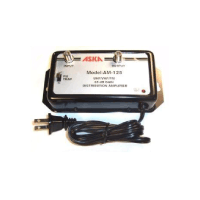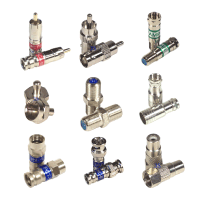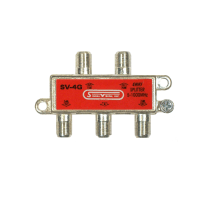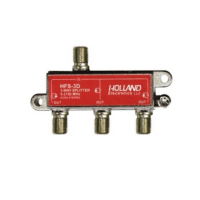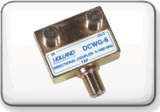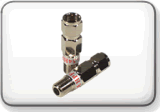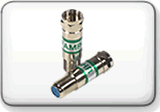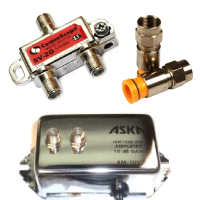
Signal Splitters
This Category of Passives provides the means to inter-connect all the "F" Connectorized RG Cables used for Transmission and Distribution lines in Your Commercial or Home System to Feed End-Use Subscriber Equipment like Receivers, TV's and DVR's.
Each of these Components Introduces a Loss of Signal (Sometimes Non-linear) and Like the Cable Utilized, these Losses need to be Accounted and Compensated for.
Splitters are obviously needed to turn one cable from your antenna into as many feeds as you need for Multiple TV locations and sets, but nothing is free... There is no such thing as a splitter without loss. If you split a signal into two, then half goes one way and half goes another.
Actual loss is not linear when measured in dB, and if you had good signal before, one two-way splitter shouldn´t impact that, unless you were just above threshold. If you wish to connect more than two TV sets, you may want to consider the addition of an amplifier to your system to zero the loss out. The Most Common Interference and Picture Loss Problems are as a Result of Introducing Splitters to Feed more Outlets and not Compensating for the Losses!
COAXIAL CABLE CONNECTORS
The most Popular Connector Series from Manufacturers like PCT, PPC, F-Conn, Thomas and Betts, Holland Electronics, Apica and Digicon offered in Legacy Hex Crimp styles as well as the Newer Radial Compression formats. Be Sure and match Connectors to their respective Crimping Tools by Manufacturer Spec. Sheet for Hex Diameter size or Compression length. Coaxial Cable Connectors should be weather protected in outdoor use, and some connectors provide extra moisture migration protection when compared to others. Though the economics of Old school Hex Crimp connectors and Tools may be attractive at first, over the long haul, compression connectors offer greater Shield Connection integrity, Bandwidth, Interference Rejection and Impedance matching when compared to their Hex Crimp counterparts. Whenever possible, upgrade Coaxial Cable, Connectors, Splitters and Amplifiers to ensure compliance to the latest specifications and formats.
AMPLIFIERS
All of these Amplifiers will Pass HDTV, DTV and Analog Signals. Those that have a Specific Band-Pass of up to at least 890 MHz are good for VHF/UHF and FM also... Making Them Suitable for Home use of Off-Air Antenna Television Carriage. Those Amplifiers with Band-Pass Specific to 2150 MHz means that they Boost Satellite Signals... If these same Amplifiers have a Start Frequency of between 5 and 54 MHz, they are Wide-Band and Carry Cable TV or Off-Air in Addition to the Satellite Signals. If the Star Frequency is around 950 MHz, then they are Solely for Satellite Carriage.
- Amplifiers- Should be utilized for these two reasons:
- To increase already adequate signal as to pre-emphasize the level to balance out losses after the amplifier such as splitters and cable in the distribution system on its way to various TVs in the house, and
- To maintain Signal level to noise at the origin (your antenna) so that low signal levels from far away stations are not lost in a longer than average cable run to the location in the house where the signals would be further distributed to the TVs desired.
Amplifiers and Preamplifiers come with various gain numbers.
Old Analog signals needed a high Carrier to Noise to get a high Signal to Noise Ratio of the Picture on your TV set, it was a one to one relationship and more was sometimes better. Digital Signals are lower in amplitude in comparison to Analog (a benefit) and that commensurately, the threshold at the TV is lower for a perfectly good picture. Very little in between, you either get a good picture or you don´t. Snow in the old analog pictures has been replaced by "Tiling" or little blocks within the picture not keeping up with the scene changes in today´s Digital TV viewing. Tiling is therefore today´s Digital Snow. It means (more often than not) that you are not far enough above the threshold of signal level into your TV to prevent little hiccups, drop-outs and interferences in signal from interrupting the Stream of Data. Remember that lots of things can happen from the Station on the way to your TV set!
PREAMPLIFIERS
Preamplifiers are mistakenly used with the rational that it will bring in Stations that weren´t there before... It won´t, and what´s worse, using the same antenna and pre-amp with FM and TV stations close by (20-30 miles) may overdrive the amp and actually impede your ability to provide goods signals to you TVs. If you desire to use a preamplifier, don´t use a high gain when you have local stations, get one with a FM trap to keep FM radio stations from over-driving the amp and remember that today´s Digital Signals don´t need to be high to get a picture. Some Pre-amps come Band Selective as well, realizing that the difference in antenna UHF/VHF gain means that one band needs to be amplified as opposed to the other.
The gain of a Line Amplifier should be selected to zero out the loss that follows it. In other words, if you have fifty feet of cable and a two-way splitter, then a 10 db amplifier will be fine. Conversely, if you have an eight-way splitter and hundreds of feet of cable, you will need an amplifier with a higher gain. Just as in the case of a Pre-Amplifier, however, bigger is not always better.
COMBINERS
"Splitters" can also be used as combiners equally as well, exhibiting the same loss over frequency characteristics. If you desired to get stations from two or more different directions, you could install and aim two or even three antennas and combine the outputs back onto one cable, amplify and distribute the signals around the house like a Mini-Cable TV System!


